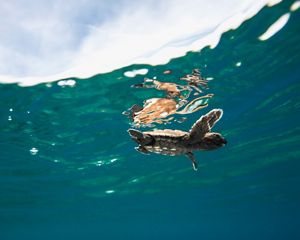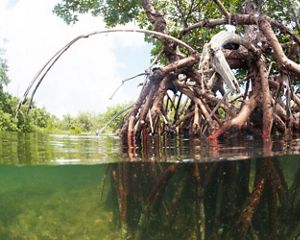Update: In March 2023, the world’s governments finalized a new United Nations Treaty for the High Seas.
See TNC's press statement.
See Ten Things You Should Know About the High Seas Treaty.
Half of the oxygen we breathe – however far inland we make our homes – comes from the ocean. It is a source of food and income for more than 3 billion people, the vast majority in developing countries, each year. From the Atlantic Coast near Lisbon where I’m meeting with global leaders this week to discuss ocean conservation, to the tidal wetlands of the Potomac River where I live, the global ocean touches all of our lives.
But our ocean faces many threats. Only 8% of the ocean is legally protected and about a third of the world’s monitored fisheries are overfished. Globally, we have already lost a third of our mangroves and half of all coral reefs. Marine species including some sharks, whales and turtles could face extinction.
In order stop these threats we must increase ambition for marine conservation both at a national level and by bringing up global standards. Last week’s working group session for the Convention on Biological Diversity, the negotiations to finalize a new treaty for the High Seas in August and the UN Conference of the Parties intergovernmental meetings on biodiversity and climate change planned for later this year offer critical opportunities to take action.

A growing body of scientific and economic research supports the Campaign for Nature’s call for a global goal of protecting 30% of the planet’s lands and waters by 2030 to avoid catastrophic biodiversity loss. More than 100 nations are supporting this goal, with many committing such protections within their own lands and exclusive economic zone of the ocean. And for our part, The Nature Conservancy is working with partners to conserve 50 million hectares of lands—an area twice the size of India—and 4 billion hectares of ocean, or more than 10% of the world’s ocean area. And last week’s Convention on Biological Diversity Open Ended Working Group meeting in Nairobi demonstrates nations’ commitment to an ambitious 30x30 goal, which we hope to see codified at the CBD COP later this year.
When we talk about addressing the climate and biodiversity crises, land protection goals often take center stage. But we need to be talking about the ocean, too. And when nations like Colombia, Gabon, Belize and Seychelles step up to lead on their marine commitments, TNC and other NGOs stand ready with solutions for financing innovation and working alongside community leaders to plan for solutions that balance fishing, climate mitigation and adaptation and habitat conservation – all topics that I look forward to discussing at this week’s UN Ocean Conference in Portugal:
We must turn commitments into action: To support implementation of the 30x30 target and protect more of the ocean, TNC is bringing practical tools to the table to help political decision makers and planning practitioners through the Marine Protected Areas (MPA) Toolkit we have co-developed with UNEP and the MPA cost and benefits model we have put together with Anthony Waldron.
Innovative financing will bring meaningful change: The greatest barrier to advancing marine protection is funding. We believe that a variety of innovative financing mechanisms can unlock $1.6B for marine conservation:
- Blue Bonds for Conservation are bold solutions that can simultaneously reduce countries’ debt burden while increasing investment in conservation. Based on partnerships between TNC and governments who are fully committed to protecting their ocean using a transparent, public participatory process, we plan to deliver on our ambitious goal of protecting 30% of the world’s ocean.
- As corporations make ambitious net-zero commitments, demand for carbon offsets has increased substantially and is likely to continue on that trajectory. Carbon credit inventories are shrinking and competition among corporate offset purchasers is high. New blue carbon projects can generate hundreds of thousands of new credits to meet this growing demand. TNC is working with the Blue Carbon Buyers’ Alliance to establish credible, science-based norms for this emerging market. And we’re strengthening community resilience through several partnerships focused on restoring and protecting coral reefs, oysters, and mangroves.
- Insuring coral reefs against future risk as the climate changes can provide critical funds for restoration and management efforts.
- Through a new blended finance vehicle established by a coalition of partners including UN agencies, financial institutions and private philanthropy – called the Global Fund for Coral Reefs (GFCR) – we are protecting vital ocean habitats, like coral reefs, that support a quarter of all marine life. Through the GFCR and partners, we are facilitating investments in reef conservation and de-risking investments in reef-positive businesses that support the resilience of coral reefs and communities around the world.
Quote: Jennifer Morris
In order stop these threats we must increase ambition for marine conservation both at a national level and by bringing up global standards.
There is no solution to the climate crisis without nature: Natural climate solutions offer opportunities to stop the most harmful effects of the climate crisis through the ocean’s ability to absorb and store carbon. This, along with costal defenses, will enable people, nature and our communities to adapt to a changing climate.
Maintaining life and livelihoods: Restoring balance to marine ecosystems is a delicate process and we must make sure that people are at the center of the solution. We cannot expect a community whose livelihood depends on fishing to restructure its entire economy without the support of durable financing and innovative solutions. Moreover, collaboration with local communities, governments and Indigenous leadership is critical for better management of marine ecosystems —whose services are valued at more than US$49 trillion.
- For example, the Pacific Island Tuna partnership between TNC and the Republic of the Marshall Islands is designed to transform the global canned tuna supply chain. The partnership, which will supply sustainable canned tuna to Walmart stores across the United States, includes strict sourcing standards that match robust social and environmental sustainability commitments, and provisions to ensure that local communities benefit directly from the profits. The innovative business model works for the benefit of all and can be applied to more fisheries around the world.
Ensuring our ocean remains resilient is no easy task, but protecting it is too important to the future of the planet for us not to succeed. And it is too urgent to wait any longer. At TNC we have over 50 years of experience of meeting ambitious goals through innovative solutions and radical collaboration. We know that when we work together across sectors and experiences, we can create a world where nature and people thrive.
So take a deep breath and dive in – it’s time to take action, together, now.
Global Insights
Check out our latest thinking and real-world solutions to some of the most complex challenges facing people and the planet today.




